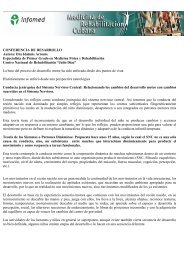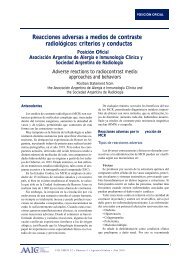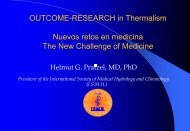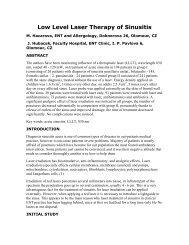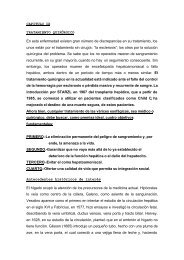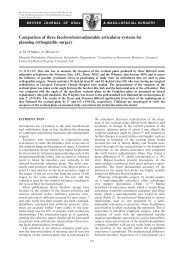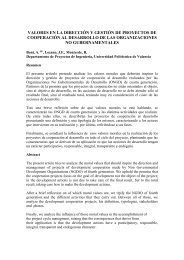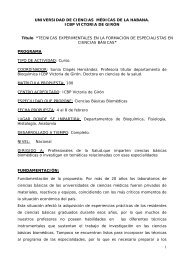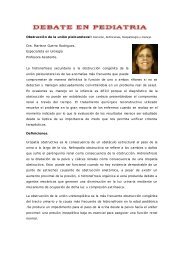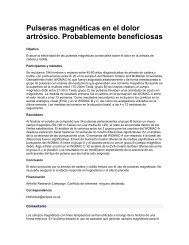Perioperative Anaphylaxis
Perioperative Anaphylaxis
Perioperative Anaphylaxis
You also want an ePaper? Increase the reach of your titles
YUMPU automatically turns print PDFs into web optimized ePapers that Google loves.
430<br />
Mertes et al<br />
Determining the cause of these adverse events and the drug responsible, and<br />
adequately communicating those findings, can reduce second reactions.<br />
EPIDEMIOLOGY<br />
<strong>Perioperative</strong> anaphylactic reactions are potential life-threatening immediate hypersensitivity<br />
reactions that are unrelated to the drug’s pharmacologic characteristics<br />
and correspond to immune-mediated allergic and nonimmune-mediated so-called<br />
‘‘pseudo-allergic or anaphylactoid’’ reactions. 3 They result from the release of preformed<br />
and newly synthesized mediators from mast cell and basophils.<br />
The reality of the risk of an allergic reaction occurring during anesthesia is established<br />
on the basis of the more than 15,000 cases of perioperative hypersensitivity<br />
reactions published in the literature during the last 20 years. 4 Despite increasing<br />
awareness about anaphylactic reactions to drugs and compounds used in anesthesia,<br />
their incidence remains poorly defined owing to uncertainties over the accuracy and<br />
completeness of reporting.<br />
Most reports on the incidence of anaphylaxis originate in France, Australia, New<br />
Zealand, the United Kingdom, Thailand, Spain, and Norway. They reflect an active<br />
policy of systematic clinical or laboratory investigation of hypersensitivity reactions,<br />
or result from the analysis of drug-related adverse event databases. Based on these<br />
reports, the estimated incidence of all immune- and nonimmune-mediated immediate<br />
anesthetic hypersensitivity reactions was 1 in 5000 to 1 in 13,000 in Australia, 1 in 5000<br />
in Thailand, 1 in 4600 in France, 1 in 1250 to 1 in 5000 in New Zealand, 1 in 3500 in<br />
England. 4–8<br />
The estimated incidence of immune-mediated reactions was 1 in 10,000 to 1 in<br />
20,000 in Australia, 9 1 in 13,000 in France, 10 1 in 10,263 in Spain, 11 1 in 5500 in<br />
Thailand, 8 and 1 in 1700 to 1 in 20,000 in Norway. 12 In most series, they represent<br />
at least 60% of all hypersensitivity reactions observed within the perioperative<br />
period. 11,13–16 Wide variations are reported concerning the expected mortality rate,<br />
ranging from 3% to 9%; 17,18 the overall morbidity is unknown.<br />
CAUSAL AGENTS<br />
The overall distribution of the various causal agents incriminated in anaphylaxis during<br />
anesthesia is similar in most reported series. Neuromuscular blocking agents (NMBAs)<br />
Table 1<br />
Substances responsible for IgE-mediated hypersensitivity reactions in France: results from seven<br />
consecutive surveys<br />
Substance<br />
1984^1989<br />
(n 5 821)<br />
(%)<br />
1990^1991<br />
(n 5 813)<br />
(%)<br />
1992^1994<br />
(n 5 1030)<br />
(%)<br />
1994^1996<br />
(n 5 734)<br />
(%)<br />
1997^1998<br />
(n 5 486)<br />
(%)<br />
1999^2000<br />
(n 5 518)<br />
(%)<br />
2001^2002<br />
(n 5 502)<br />
(%)<br />
NMBAs 81.0 70.2 59.2 61.6 69.2 58.2 54<br />
Latex 0.5 12.5 19.0 16.6 12.1 16.7 22.3<br />
Hypnotics 11.0 5.6 8.0 5.1 3.7 3.4 0.8<br />
Opioids 3.0 1.7 3.5 2.7 1.4 1.3 2.4<br />
Colloids 0.5 4.6 5.0 3.1 2.7 4.0 2 .8<br />
Antibiotics 2.0 2.6 3.1 8.3 8.0 15.1 14.7<br />
Other 2.0 2.8 2.2 2.6 2.9 1.3 3.0<br />
Total 100 100 100 100 100 100 100



